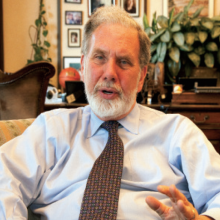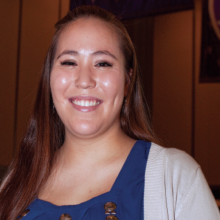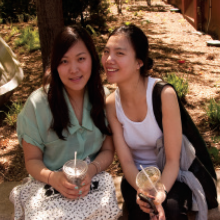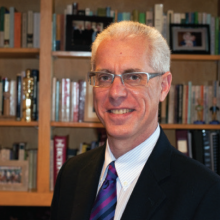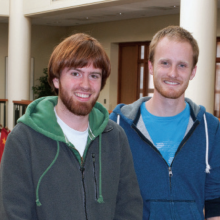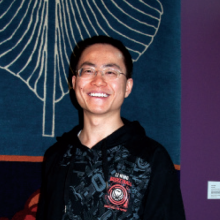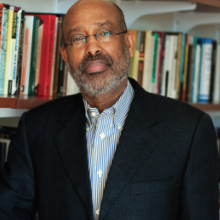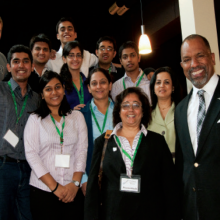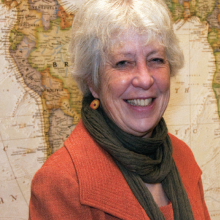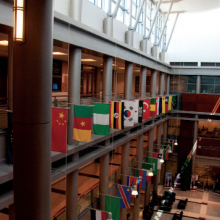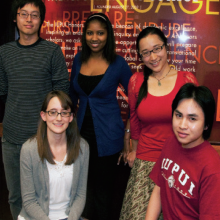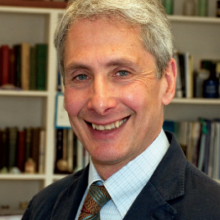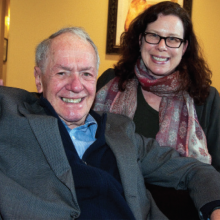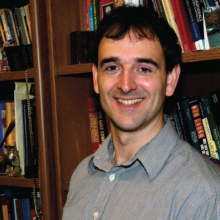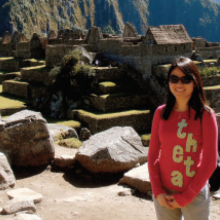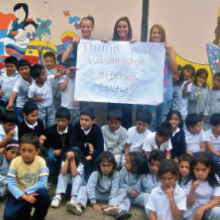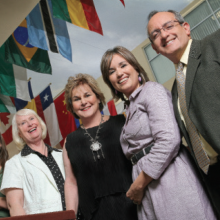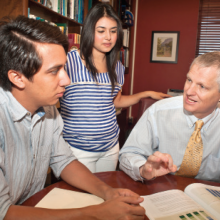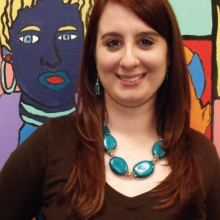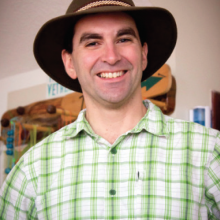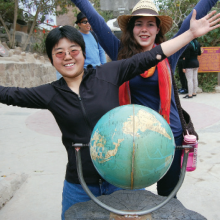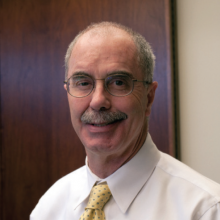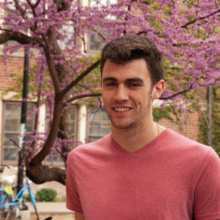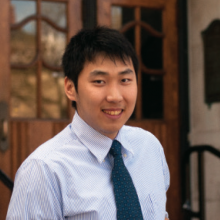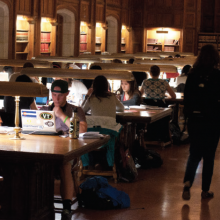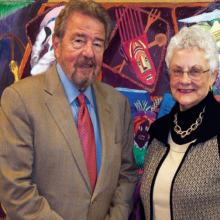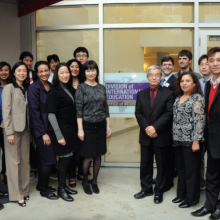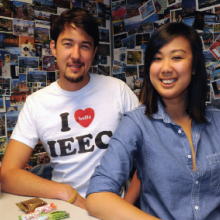2011 Comprehensive New York University
New York University’s prodigious number of international students (7,200) and participation in education abroad (4,300) have long solidified its place among the most international U.S. universities. Now it has laid claim to the title of the world’s first “global network university,” with a new liberal arts college open in Abu Dhabi, a second in the works for Shanghai, and nearly a dozen other sites around the world where NYU students go to study. Most of its 43,000 students still throng the buildings with their signature violet flags that surround Washington Square. Amending the 1831 pronouncement by Albert Gallatin and other founders that they were creating a university “in and of the city,” President John Sexton describes today’s NYU as “in and of the world.”
Sexton, seated in his office atop red sandstone Bobst Library with a red-tailed hawk nesting outside his window, said the concept of the global network university is still evolving, but like a Polaroid picture becoming clearer over time. It is not, he emphasized, merely a hub-and-spoke arrangement or set of affiliated branches. “We see the university as an organism, a circulatory system” for faculty and students to move between continents for learning and research, Sexton said. He recalled a conversation over breakfast at Chequers with then Chancellor of the Exchequer of Britain Gordon Brown, who remarked that NYU’s ambitious conception brought to mind the Italian Renaissance “and the way the talent class moved among Milan and Venice and Florence and Rome.” That captures in a nutshell “the world view in which we see ourselves operating,” said Sexton.
The peripatetic Sexton had just returned from a 12day journey to Abu Dhabi, Singapore, South Korea, and Abu Dhabi again. A Brooklyn native, Sexton was schooled by the Jesuits at Fordham University to be a professor of religion, then retooled at Harvard Law School as a legal scholar. He has played a multitude of parts—champion high school debate coach, clerk to the Chief Justice of the United States, law school dean, and chairman of the Federal Reserve Bank of New York. He is wont to quote Teilhard de Chardin, Martin Buber, Diogenes (“I am a citizen of the world”), and Charley Winans, his mentor and faculty legend at Brooklyn Prep.
Seeking an Edge in Global Talent Competition
Sexton believes NYU has gained an edge in a global competition for talent, such as the prominent economist it landed by offering to let him teach every fourth year in Abu Dhabi, closer to his wife’s family in Pakistan. He can envision the future Shanghai campus luring a world-class mathematician with aging parents in China. Already Sexton and Alfred Bloom, vice chancellor for NYU Abu Dhabi, boast of creating “the world’s honors college” in the Middle East emirate. NYU and its Abu Dhabi patron flew several hundred high school seniors to the emirate for weekend visits before admitting the first class of 149, one-third American. The median SAT verbal and math scores were 1470. NYU Abu Dhabi in May awarded $16 million over five years for four joint-faculty research projects that will be based in Abu Dhabi and deal with climate modeling, computer security and privacy, cloud computing, and computational physics. Sexton has promised that all of NYU’s overseas operations will be self-sustaining and won’t siphon resources from Washington Square.
Vice Provost for Globalization and Multicultural Affairs Ulrich Baer presides over NYU’s 10 global academic centers for education abroad in Accra, Ghana; Berlin, Germany; Buenos Aires, Argentina; Florence, Italy; London, England; Madrid, Spain; Paris, France; Prague, Czech Republic; Shanghai, China, and Tel Aviv, Israel. Two sites are planned for Sydney, Australia, and Washington, D.C., and Sexton expects to open two more in South America and South Asia. With Abu Dhabi—Washington Square students will be able to spend a semester there—NYU’s global network will feature at least 16 sites by 2014.
Baer, who rowed crew at Harvard as an international student from Germany and did his PhD in comparative literature at Yale, has authored books on photography and the poet Rainer Maria Rilke and edited a literary anthology about the September 11, 2001, attacks on the World Trade Center. Apart from providing academic and intellectual leadership for NYU’s global network, Baer’s duties now include negotiating long-term leases for more housing in London and Paris as well as explaining to NYU students why they can party in dorms in some parts of the world but not others. “The university is just starting to grasp what it means to operate globally like most corporations do,” he said. “You move people around. When you’re in Shanghai, do we pay for your dental insurance or not?”
“I felt like I had died and gone to international education heaven.”
An Ethos of Education Abroad
Given the size of NYU’s education abroad program, it might be expected that this enterprise operates from a high visibility office with heavy foot traffic. That is not the case. Although NYU aspires to soon unify international operations in a single location, Baer and the Office of Global Programs currently occupy a suite on the eleventh floor of Bobst Library, while most education abroad staff work out of the lower level of a high-rise residence ten blocks away. They make education abroad pitches at innumerable orientation sessions but leave it to academic advisers within NYU’s 16 schools to close the sales. “Each college has a point person. By the time they get to us, they typically have decided,” said Associate Director Jaci Czarnecki. “We might meet with them to talk about which location makes the most sense and what they need to do to apply and be admitted and get there.” Education abroad is so ingrained in the NYU experience that most students don’t need a lot of convincing, she added.
Some undergraduates are admitted to spend their first year at NYU centers in Florence, London, Paris, or Shanghai. Sophomore Mercedes Moya, U.S. born but raised in Paris, started at La Pietra, the Florence estate where students live and attend classes. “For me, New York is abroad,” said Moya, a politics and Italian major. “It was the city that drew me here. New York is definitely the capital of the world.”
Nearly 1,000 business majors study abroad each year, according to Susan Greenbaum, associate dean of the Stern School of Business. Over spring break last March, Stern flew 650 juniors in its international economics course to Budapest, Buenos Aires, or Singapore to visit businesses. An alumni benefactor supports the program. Stern also now offers a business and political economy degree in which students spend two semesters in London and a third in Shanghai. “We hope that we’ve lit them on fire” for work in the international arena, Greenbaum said.
Wanted: More International Undergraduates
The Office for International Students and Scholars (OISS) already occupies prime real estate a block from Washington Square. NYU enrolls more than 6,700 international students—one-third are undergraduates. The countries that send the most students to NYU are South Korea (1,400), China (almost 1,200), and India (more than 1,000). Most pursue master’s degrees or PhDs, but the 2,035 international undergraduates are double the number of five years ago. (Some 1,000 graduates are on Optional Practical Training.) OISS director David Austell said that when he arrived at NYU in 2007, “I felt like I had died and gone to international education heaven.”
Sexton aims to boost the number of international undergraduates from 9.1 to 20 percent. Freshman Hyun Seok Oh, a permanent resident of Hong Kong, chose NYU because he wanted to study in a metropolis like his hometown. Oh, an economics major, said, “A campus would have been nice and everything, but the advantages here outweigh the disadvantages. It’s a great place.”
“I felt kind of lost, but then I got used to it and made a bunch of friends,” she said. Studio arts “is a small program within a huge school…(and) the advisee system is very good.”
While business is the biggest draw for international students, more than 800 are enrolled in NYU’s vibrant visual and performing arts programs. Young Eun “Grace” Lee, from Seoul, South Korea, is a studio arts major. At first NYU seemed bigger than she bargained for and “I felt kind of lost, but then I got used to it and made a bunch of friends,” she said. Studio arts “is a small program within a huge school…(and) the advisee system is very good.”
While international undergraduates live in NYU’s high rise residences, graduate students are dispersed. With sky-high rents in Greenwich Village and much of Manhattan, some find apartments across the East River in Brooklyn or across the Hudson River in Jersey City, Hoboken, and other areas linked to the city by rapid transit.
The plan is to eventually enroll 2,000 students at NYU Abu Dhabi and as many as 3,000 in Shanghai, which will start in 2013. Sexton enlisted May Lee, an NYU-trained lawyer and banker, to negotiate terms with the Chinese Ministry of Education, Shanghai’s municipal government, the government of the special Pudong district, and East China Normal University. Lee, associate vice chancellor for Asia and daughter of Chinese immigrants, said the idea of bringing American-style education to China and helping the Chinese build a bridge to Westerners “really struck a chord with me.”
Turning Students Into ‘Inspired’ Jazz Musicians in Europe
Faculty in this large, decentralized university continue to find ways to entice U.S. students to venture into the world. David Schroeder, director of jazz studies, has turned Florence and Prague into favored destinations for music majors. “Nobody wants to leave New York as a jazz musician,” said Schroeder, but while his students are treated as greenhorns in Manhattan, “in Europe they’re considered those young, inspired jazz musicians from New York City.”
Junior Zach Feldman, 20, a music business major, was a deejay at the Hard Rock Cafe Prague and arranged parties that drew hundreds to other clubs in fall 2010. “It was really cool, dealing with club owners who didn’t speak any English,” he said. “Literally half the sophomore class (of music business majors) is going to Prague next semester (fall 2011).”
Some 4,349 undergraduates studied abroad in 2009–10. Among the three-quarters who had declared a major, only 52 were language majors. Some global centers require language study, but most courses are taught in English. Associate Professor of Sociology Tom Ertman began the Berlin program in 2005 with non-German speakers in mind. “You could (never) run a program out of here targeting German students because there weren’t enough of them,” said Ertman. But lots of students were intrigued by the German capital’s image as “a cool, young, happening place.” Some 140 students study there each year, including large numbers from NYU’s Steinhardt art programs.
What China Wants From Washington Square
Xudong Zhang, a comparative literature professor and chair of East Asian studies, said Chinese language enrollments have grown “at an explosive rate” and now top 1,000. Zhang helped launch the Shanghai education abroad center in 2006 and directs China House, one of the NYU language and culture centers. China House soon will move into a new home alongside La Maison Française and Deutsches Haus on charming Washington Mews, a gated block of converted nineteenth century stables.
Zhang grew up in Shanghai, the son of naval research engineers. East Asian studies, he said, will be “no more special than other departments” in the partnership with East China Normal University. “What leading Chinese universities want from us is not ethnic Chinese faculty like me; they want our best researchers in science, social sciences, and the arts.”
President Sexton knows what his partners want and what NYU wants, which is to become one of the two or three dozen premiere research universities in the world. Many rivals have greater space and more resources, Sexton averred, but they cannot match NYU’s “locational endowment”—New York City—and “attitudinal endowment”—its aggressive entrepreneurship.


